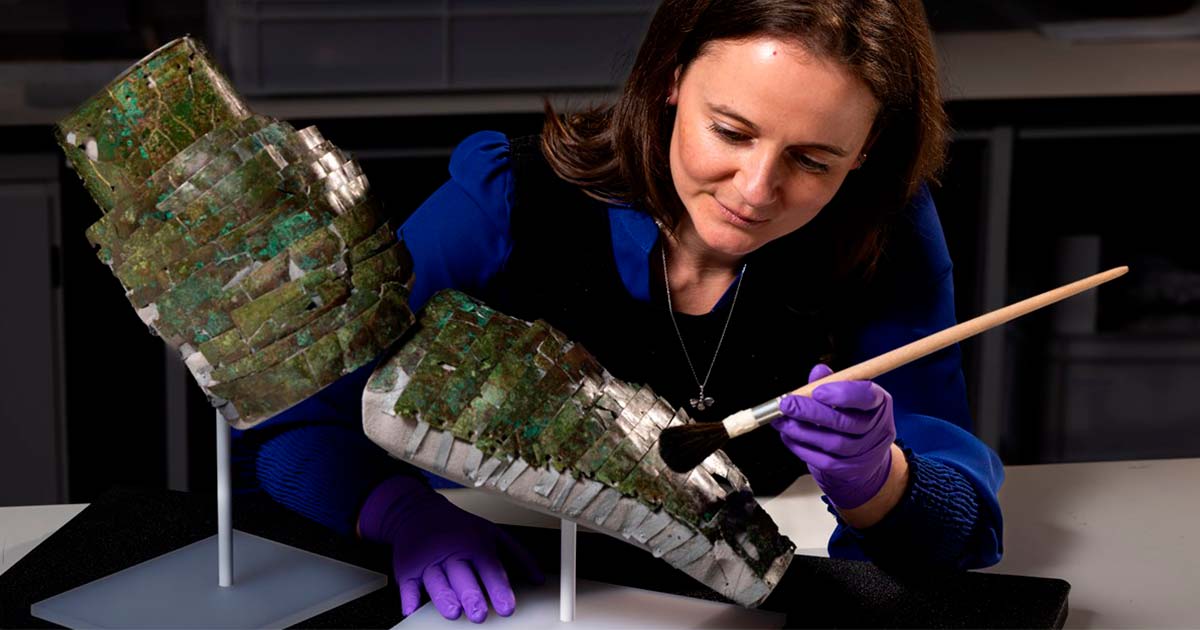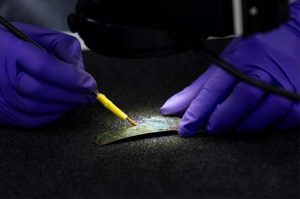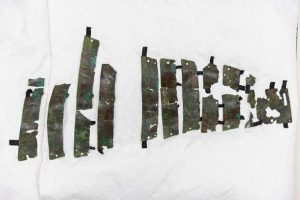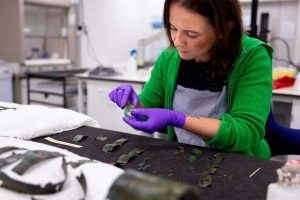“Remarkably Outstanding” Reassembled Roman Arm Guard 1,800 Years Later

Over 100 years ago, a Scot unearthed over 100 fragments of metal which he thought comprised a Roman chest guard. Now, National Museums Scotland have reconstructed the artifact and discovered that it was a high-ranking Roman soldier’s brass arm guard—“only the third of its kind known to exist.”

The Roman arm guard was originally discovered at the Trimontium fort by lawyer and antiquary, James Curle, in 1906. The site is named after the three Eildon Hills which the fort overlooks and is located at Newstead, near Melrose, in the Scottish Borders. Having been occupied by around 2,000 invading Romans between 79 to 184 AD, it represents the largest outpost fort after the construction of Hadrian’s Wall in the 120s AD.
Ancient Chinese Paper Armor Was Tougher Than Steel
Roman Centurions: Elite Forces of the Roman Empire’s Military
Curle initially believed he had found chest and shoulder armor, and it was only in the 1990s the piece was identified as a Roman arm guard. National Museums Scotland (NMS) in Edinburgh recently tweeted saying more than 100 fragments from the 1,800-year-old brass Roman arm guard, that was designed to protect the sword arm of a high-ranking Roman soldier, have now been reconstructed. The organization also stressed that the artifact is “the only intact example of its kind.”
The Roman arm guard during conservation. (Duncan McGlynn / National Museums Scotland)
The Roman Arm Guard and the Glamour of War
Dr. Fraser Hunter, the principal curator of prehistory and Roman archaeology at NMS, told The Observer that “the armguard is absolutely amazing, and only three have ever been recovered from the Roman Empire.” Furthermore, it’s also the most intact of the three. The researcher said the ornate overlapping brass strips would have shone like gold on the warrior’s arm, perhaps signifying his rank from within the smog of war.
Dr. Hunter said that the Roman arm guard was “a critical piece of a legionary’s kit.” It’s scaled design “would have deflected any blow,” as well as stopping their tibias from shattering, Roman soldiers wrapped cloths around the arm, beneath the guard, to absorb impact shocks. The researcher added that it is known legionaries occupied the fort. Meanwhile, because of the “glamorous brass fixings” it was probably worn by “a high-ranking centurion.”

Piecing together the 1,800-year-old Roman arm guard was described as akin to working on a historic jigsaw puzzle. (Duncan McGlynn / National Museums Scotland)
What is the Roman Arm Guard Doing There? They “Just Dumped It”
Bethan Bryan, the NMS’s artifact conservator, said that the historical jigsaw puzzle took about three weeks to complete. During this long and arduous process, they explained that the task “sometimes seemed impossible, because some of the fragments are tiny.”
The fragmented Roman arm guard was discovered in the headquarters of the site’s latest fort. Dr. Hunter explained that this would have been where the commanding officer briefed his officers, as well as being where weaponry was repaired in a workshop. In conclusion, the Roman arm guard appears to have been left behind when the Romans abandoned Trimontium. In Hunter’s own words, “it was deemed surplus to requirements, they just dumped it.”

Conservator Bethan Bryan working on the Roman arm guard. (Duncan McGlynn / National Museums Scotland)
Enforcing the Strong Arm of the New Law
During the Roman imperial period, the term “Caledonia” referred to the region north of the River Forth, while England, to the south, was known as “Britannia.” Roman legions arrived in Scotland around AD 71, seeking to complete the conquest of Britannia, and Trimontium was built in a strategic location on the borders.
During this era, Campaigns led by Q. Petilius Cerialis and Gn. Julius Agricola targeted the Caledonians in the 70s and 80s. Tacitus’s The Agricola records the Roman victory at the battle of Mons Graupius, associated with the Grampian Mountains.
The Armor That Broke Away from All Established Standards (Video)
Gladiator Helmets: Fit for Purpose, Not Just Protection
A 2023 report in Ancient Origins delved into the rediscovery of a lost Roman road built by Julius Agricola in Drip, near Stirling, described as “the most important road in Scottish history.” Who knows, but the high-ranking soldier wearing the protective arm might have marched north from Trimontium, and into the highlands, during the Roman conquest of Caledonia.
The Roman arm guard fragments have been stored in NMS’s collection for more than a century, and until now, only one sliver was on display, with another on display at Trimontium Museum in the Scottish Borders. Now, the Roman arm guard will be lent to the British Museum’s forthcoming exhibition on life in the Roman army